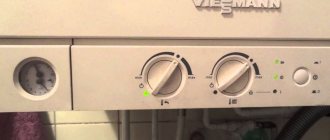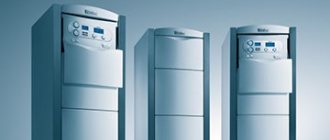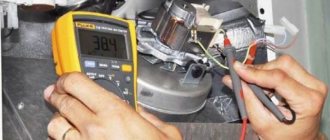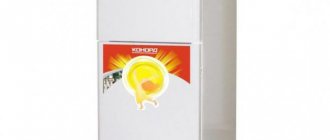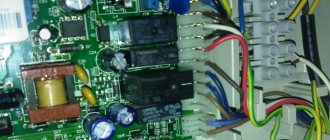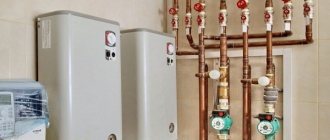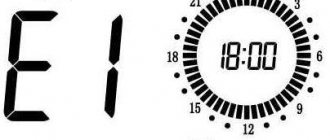The Arderia gas boiler is a popular equipment for arranging heating and hot water supply systems. A manufacturer from South Korea produces two types of boilers, bithermal and with two heat exchangers. The equipment is characterized by reliability. To ensure safety, a pump with a dry rotor is used. This prevents blockages and avoids water contact with the engine. Any equipment can one day fail and the error codes of the Arderia gas boiler will help to find out the cause of the malfunction.
Who is the manufacturer
The ARDERIA boiler brand appeared on the Russian market relatively recently, 12 years ago, then a joint Russian production was created with the South Korean company DAYSUNG SELTIC, first in the form of an OEM project with adaptation to Russian heating equipment, then the SAUDI CERAMIC line and Bulgarian ELDOM were added. and Italian "ELBI".
In 2015, the ARDERIA company in Russia expanded with new production facilities, a logistics and support technical complex with a modern laboratory, all of this is located at 6.5 thousand. m2 in the Krasnodar village of Enem.
Main types
The Arderia brand is the property of the South Korean company Daesung. The products of this company are widely known in the world and are in high demand. The main feature of the company is its approach to the production of heating equipment.
Most work operations are performed by automated lines, which eliminates miscalculations or negligence. The Arderia brand was created to place gas boilers on the Russian market, which were produced in the following types:
By type of installation:
wall-mounted Designed for hanging installation indoors (usually in kitchens).
Floor-standing models are not produced, as they require a separate room and are in less demand.
By set of functions:
- single-circuit. Designed only to supply the heating system with hot coolant at a given temperature;
- double-circuit. The units are prepared for simultaneous heating of the coolant and supply of hot water;
The following types of heat exchanger are available:
- with separate heat exchanger. These are boilers in which the primary unit consists of pure copper (99%), demonstrating high resistance to temperature changes and the absence of corrosive processes. The secondary heat exchanger is made of stainless steel, has high heat transfer capacity and shows remarkable performance;
- with bithermic (combined) heat exchanger. This is a “pipe-in-pipe” design. The coolant and water for the hot water supply line simultaneously pass through it without mixing with each other. This design allows you to significantly increase and stabilize the hot water supply at home, but requires taking all possible measures to protect against scale. The complex cross-section of the heat exchanger pipe is very difficult to clean, and replacing a defective unit is too expensive and is not carried out everywhere.
NOTE! The design of the boilers meets modern requirements for the functionality and efficiency of heating technology. The units have all the necessary certificates and can be used in residential and public premises.
Specifications
The Arderia line of gas boilers is presented with one or two circuits with a power from 10 to 40 kW. They are capable of heating a house with an area of 60 to 400 m2 and preparing hot water for a family of 4-6 people. The units integrate well into Russian engineering networks, although to protect electronic boards, it is recommended to install stabilizers along the electrical line.
Arderia boilers are energy-efficient devices, the efficiency reaches 90.5-91.7%. This is ensured by a modern thermal process and the use of auxiliary equipment: a DC blower fan and a centrifugal circulation pump.
Design characteristics of ARDERIA devices:
- Heated area, from 60 to 400 m2;
- Dimensions (WxDxH), 460x205x700 mm.
- Weight, from 23 to 26 kg.
- Efficiency, from 90.5 91.7 to% 91.1 90.4 91.3 91.7.
- Useful thermal power, 10 to 400 kW.
- Hot water productivity, at a temperature difference of 25 C 8.7 to 23.3 l/min.
- Minimum/maximum coolant pressure is 3/10 bar.
- Electrical power consumption, from 110 to 155 W.
- Coaxial chimney internal/external diameter 75/100 mm.
- Expansion tank volume, 5.3 l.
GAS BOILER ARDERIA ESR 2.13 FFCD
Arderia boilers are wall-mounted gas boilers with a closed combustion chamber designed for heating and hot water supply with a capacity of 16 to 40.7 kW.
Arderia boilers are produced by the leading heating equipment manufacturer in South Korea, Daesung. They combine efficiency, high quality and exceptional reliability.
Quality control at every stage
Daesung uses the Toyota assembly system in which all employees are personally responsible for each boiler produced. By the boiler number you can easily determine who assembled it, what batch the components were from and who carried out the quality tests. Afterwards, all Arderia boilers are tested in operating mode with the connection of gas, a heating circuit and a hot water supply circuit. From each batch of 500 pieces, 2 boilers are selected for more thorough testing in a special laboratory. After testing, the quality inspector puts his personal stamp on each boiler and if a defect is discovered in the future, all personnel will be personally responsible for this.
Built-in voltage stabilizer
Thanks to the presence of a built-in voltage stabilization system, the boiler remains operational during voltage fluctuations in the range from 150 to 286 volts. No additional installation of stabilizer is required.
Minimum operating gas pressure 4 mbar
Arderia boilers are fully adapted to Russian conditions and can operate stably at a minimum gas pressure of only 4 mbar.
Dry rotor pump
Over time, dirt, scale and rust form in the heating system. This leads to breakdown of wet rotor pumps. Arderia boilers use dry rotor pumps, for which this problem does not exist. In pumps with a dry rotor, there is no contact of the coolant with the rotating rotor of the electric motor, thereby the rotor is completely protected from jamming and clogging. It is also worth noting that the efficiency of pumps with a dry rotor is much higher. All pumps for Arderia boilers are manufactured at a plant in South Korea, which is part of the well-known international Grundfos group.
Supercharging with DC fan
Most boilers use AC fans after the combustion chamber. Such fans can only operate at one speed. But chimneys of different lengths require different pressures, and different amounts of air are needed to burn different amounts of gas. Using an old design fan it is impossible to create the necessary conditions for optimal boiler operation.
Arderia boilers are equipped with a DC fan that can operate at any required speed. It provides optimal air pressure at any given moment. Since it is located in front of the combustion chamber, it does not create a vacuum, but a pressurized air. It supplies the combustion chamber with as much air as is needed for the boiler to operate efficiently.
Protection system
Each boiler has a reliable safety system, which includes: ionization flame control, overheating protection, freezing protection and a self-diagnosis function. All necessary parameters are constantly monitored by the boiler automation.
Two heat exchangers
High operating efficiency is ensured thanks to two separate heat exchangers. The reliable copper primary heat exchanger has a long service life and high performance. For hot water supply, an additional stainless steel plate heat exchanger is used, which easily allows you to obtain the required amount of hot water at any time.
Various types of chimneys
Arderia boilers can be used with different types of chimneys (coaxial chimney 100/60 and separate chimney dy80), to change one type of chimney to another it is necessary to change the special flue mounting flanges in the upper part of the boiler.
Guarantee
The warranty period for Arderia boilers is 2 years. For the production of boilers, only proven, high-quality components and materials are used. Arderia boilers are modern equipment that provides a high level of reliability and comfort.
Maris LLC also pays special attention to the service of Arderia boilers; the necessary spare parts are always available.
Design and principle of operation of Arderia boilers
The operation of the units is fully automated and has several levels of protection. The gas boiler has two heat exchangers on the heating circuit made of copper, and in the DHW system - made of steel.
The first main heating circuit, water is supplied through the boiler by a centrifugal circulation pump, which is controlled by temperature sensors in the apartment or outdoors, with weather-dependent automation. They give a signal to increase/decrease the speed of rotation of the pump impeller and, accordingly, the speed of movement of heated water along the heating circuit. It must be equipped with a high pressure relief valve and an expansion tank.
The second circuit begins to operate when the hot water tap on the mixer is opened; in this case, the DHW heat exchanger has heating priority if a three-way valve is installed in the circuit.
Flue gases obtained from burning fuel in the furnace enter the central barrel of the coaxial chimney; air is sucked through the outer ring by a blower fan onto the burner distribution nozzle. Moving along the hot central pipe, the air is heated through the wall by the exhaust gases, which increases the efficiency of the equipment and, accordingly, increases the efficiency.
Features of Arderia equipment
Security and full automation are the main areas on which all efforts of developers are directed. That is why the design provides several additional protective devices. In general terms, the Arderia boiler has the following design advantages:
- Arderia double-circuit boilers are equipped with two independent heat exchangers. A copper heat exchanger is used for the heating circuit. A stainless steel heat exchanger is installed for the DHW system.
- Installing a pressurized burner allows the automation to independently control the power of the generated thermal energy. This also involves a forcing fan, which provides the necessary amount of air for stable combustion.
- Simple and clear automation control: you can adjust and set the required temperature values for heating and hot water in just a few clicks.
- Connecting a room thermostat allows you to control the boiler operating modes remotely.
- The modern wall-mounted arderia boiler has an electronic display, which displays current values and error codes in the event of a malfunction.
Adaptive Design Features
In addition, gas boilers of the arderia brand are fully adapted to operating conditions in Russian systems. For this purpose, the design of the device provides the following additional elements:
- The main breakdown of volatile double-circuit boilers is voltage surges, which happens quite often in our country. The manufacturer took this into account and the Arderia boiler has a built-in voltage stabilizer. The reliable operation of such a stabilizer is maintained at values from 150 to 285 volts.
- The design also includes a special gas valve and reducer, which are capable of ensuring operation of the burner when the gas pressure drops to 4 Bar.
Such design features were duly appreciated by domestic consumers, which is confirmed by positive reviews on forums and the manufacturer’s official website.
Performance characteristics
Let's look at the main technical characteristics indicated by the user manual:
- A closed combustion chamber, in addition to its efficiency, increases the safety of gas equipment, since combustion products cannot leak from it.
- A coaxial chimney with a forced fan ensures stable and reliable removal of exhaust gases in all weather conditions.
- Protection against voltage surges and anti-freeze system.
- A powerful, yet compact circulation pump ensures pumping of coolant through a heating system of any complexity and configuration.
- Electronic system for automatic ignition of the burner. In addition, the electronics provide smooth start-up and control over the flame.
- The control module has an electronic display, thanks to which the Arderia boiler is easily adjusted to the required comfort indicators.
Arderia error codes
The boiler has a modern diagnostic system for the current state of the unit, with error codes displayed on the operating panel. All errors are marked with the letter A followed by a number that characterizes the cause of the failure. Using the factory operating instructions, the user can independently figure out why it is not working and what needs to be done to repair the boilers.
Arderia boiler errors:
- A2 - low fan rotation speed, debris may have gotten under the impeller.
- A3 - malfunction of the feed pump, perhaps debris has gotten under the centrifugal wheel, bad contacts in the wiring. Possible error in the operation of the temperature sensor. If the primary device is working properly, the pump will need to be replaced with a new one.
- Error A4 - the overheating sensor has tripped: there is no coolant circulation, the three-way valve is faulty, the flow sensor is faulty.
- Error A5 - low pressure in the heating circuit: air lock, break in the heating circuit, circulation pump does not work, valves on the heating line are blocked.
- Error A6 - malfunction in the ignition system: low gas pressure, gas shut-off valve is faulty.
- A7 - a problem with the control valve; there may be a failure in signal transmission from the primary sensors.
- A9 - the temperature in the heating circuit is below 5 C, you will need to start it manually.
- AA - boiling water in the heating circuit or DHW heat exchanger; most likely there is no circulation through the heating system or the pipe surfaces are clogged with scale.
The pressure in a double-circuit boiler either drops or rises, what to do?
Hi all! The author of the site Blogvp.ru, Vitaly, is in touch! I think you will agree that it is not a very fun experience to be left without heating and hot water on winter days. And this prospect came up several times in my house. I want to tell you how I struggled with this and what knowledge I acquired in this matter.
In my house, for about six years, a gas double-circuit wall-mounted boiler ARISTON CLAS 24 FF has been working to create comfort. Undoubtedly, the thing is extremely convenient; anyone who used, for example, geysers from the early nineties will understand.
But, as they say, nothing lasts forever, and therefore sooner or later, you have to deal with the refusal of technology to perform the intended work.
And although I practiced on my Ariston, so to speak, some faults will be common to any boiler. So, let's get down to business.
The pressure in the boiler slowly drops, you have to periodically add water to the boiler
First, let's look at cases where the pressure drops all the time. This is a fairly common problem - it manifests itself in the fact that the pressure in the heating system slowly decreases and when it drops below normal, some boiler models turn off.
There are two reasons why this can happen.
Leak in the heating system
An elementary coolant leak from pipes or leaky radiators, but most often what is used as a coolant? That's right water!
Believe me! It’s not easy to detect such a leak during the heating season, but the fact is that you won’t see a puddle on the floor, unless of course it’s a serious leak. Most often, these will be just droplets and you will not see these droplets, since they quickly evaporate from heated pipes.
As a result, slowly but surely the pressure will drop. You add water over and over again and this continues to kill the radiators. Because the oxygen released from the incoming fresh water does not benefit them.
How and where to look for a leak
You need to pay attention to radiator plugs, joints or soldering of pipes and fittings. You can often see traces of water leaks in the form of rusty or salt stains. But this depends on the composition of the water in your area.
It is not uncommon for modern radiators, aluminum or bimetallic, to also become unusable, sometimes in extremely inconspicuous places, between the ribs or from below, they begin to dig in due to metal corrosion. Not rust, of course, but various chemical processes also damage them. Radiators must be carefully inspected while searching for leaks.
It will be easier to detect various types of leaks if you turn off the heating for a while, let the radiators cool and add pressure to about 2.5 Bar. After this, you will be able to see drops or puddles on the floor. Carefully inspect the floors under the radiators, pipe connections, and soldering areas.
The boiler can also be the cause of the leak. For example, the primary heat exchanger itself or its connections are leaking. But as long as these are small droplets, you will not notice anything; they evaporate during operation of the boiler. As soon as it starts to leak more actively, you will notice “drops” from the boiler.
Regardless of whether the burner is on or not, the leaking feed taps or emergency relief valve will be clearly visible.
So, the first reason for the pressure drop in the system is a coolant leak.
Expansion tank
Another reason is the expansion tank. This is a sealed container divided in half by a membrane, one half of the tank is filled with inert gas or just air, the other is filled with coolant (read water).
Expansion tank
It is designed to compensate for the pressure created during the expansion of the heated coolant.
When heated, the water in the system expands and fills its half of the tank, compressing the gas; when cooled, the coolant is again pushed into the heating system.
This is how temperature expansion in the heating system is compensated.
But sometimes the tank itself may malfunction.
Expansion tank malfunctions
For example, the tank body has lost its tightness and air is escaping from it. This does not happen often, and usually results in a fairly rapid decrease in pressure in the tank, from almost instantaneously to several days.
Also pay attention to the spool so that it does not poison the air either.
The spool (as in a car or bicycle) is located in the upper part of the tank; air is pumped through it, thereby creating the necessary pressure in the expander tank.
Another bad problem with the expander is the rupture of the membrane inside the tank, although it is not so delicate, and you need to “try” hard to break it. But if this happens, then identifying such a problem is not difficult.
In this case, the coolant enters from the heating system into that part of the tank that should be filled with air, and if pressing the spool needle throws water out of the tank, then water has penetrated where it should not be - the tank needs to be replaced.
But most often the pressure in the tank decreases very slowly, due to minor natural leaks. This decline occurs over many months or several years.
At the same time, the pressure in the expander chamber gradually decreases; naturally, it will also decrease in the readings of the boiler pressure gauge.
The behavior of the boiler very much depends on the level of this same pressure in the expander and can manifest itself in different ways. Under the next heading you will find a description of these problems.
The pressure rises and falls - the boiler does not operate stably
From all of the above, it is clear that air comes out from the part of the expansion tank in which it should be or does not have sufficient pressure. And here the pandemonium begins with changes in the operation of the boiler. All this can manifest itself in different ways and depends on the pressure in the air chamber of the Republic of Belarus.
For convenience, we will divide these manifestations into different stages.
FIRST STAGE - The pressure in the boiler drops slowly, about once a week you have to top up the boiler, while there are no obvious leaks in the expander, and there are no obvious leaks in the heating system itself.
SECOND STAGE - On the boiler pressure gauge, the pressure is constantly “walking” In heating mode it rises above 3 Bar, until the relief valve is activated; in hot water mode, on the contrary, it drops to values less than 1 bar and then the boiler may begin to shut down, the protection is activated. (If it has a pressure sensor)
THIRD STAGE - If there is absolutely no air left in the tank, then the pressure on the pressure gauge drops to zero in a very short time, sometimes in a minute.
There is only one way out for all options! It is necessary to again create the necessary pressure in the expansion tank of your boiler, in its air part.
How to pump up a boiler expansion tank
Diagram of boiler taps Ariston Class 24
A Connection for draining water into the central heating circuit (CH)
B Connection for draining water into the hot water supply circuit (DHW)
C Connection for gas supply
D Connection for cold water supply
E Connection for supplying water from the central heating circuit
S Safety valve outlet
T Drain tap
F Filling tap
How to properly pump air into the expansion tank
We follow the specified order
- Turn off the boiler from the network.
- We turn off all the taps to the boiler, supply, return, and cold water input.
- Open the drain fitting in the boiler. (T) and drain the water completely. (Here is an article about how to drain water from the boiler) The pressure in the boiler should be zero.
- We connect the pump with a pressure gauge to the RB through the spool - the drain fitting is open.
- The pump needs to pump air into the tank until water stops flowing from the drain fitting. At this stage, the main goal is to empty the tank of water.
- We release the pumped air.
- We inflate again, monitoring the pressure with a pressure gauge. The pressure in the expander should be within 1.1-1.3 bar. (See the passport for the boiler - often indicated)
- Close the drain plug.
- We open all the taps to the boiler - everything that was closed.
- We feed the boiler through the make-up tap (F) to a pressure of approximately 1.2-1.5 bar
- Let's start the boiler.
For these purposes, you can use any pump and pressure gauge. There is a car nipple there. I used an auto compressor. True, for this I had to drag the battery home. With an electric compressor, be careful to turn it off in time and not overpump.
Before starting, it will not be superfluous to expel any air that has entered the system.
In Ariston class 24, to do this, press and hold for about 5 seconds. ESK button. The boiler will go into purge mode for 6 minutes, exit this mode on its own, or you can force it by pressing ESK again.
Other malfunctions and their repairs
In addition to the standard failures that occur in the Arderia device, which can be diagnosed by the electronic control board, other errors also occur, such as the clocking of the unit, when it often turns on and off, overheating of the coolant, lack of stable ignition and combustion, and others.
Frequent outages
In a heating circuit, the boiler often turns on/off due to high coolant temperatures, usually during the transitional heating period in autumn and spring. In this case, it is better to configure the device using a room thermostat.
In DHW mode, the boiler often turns off during emergency modes due to the water pressure in the municipal water supply being less than 1.5 atm. and water flow below 2l/min. If the water utility cannot ensure the operation of the water supply system according to the specified parameters of the boiler, it will be necessary to install an additional storage tank and pump in the DHW circuit.
Temperature fluctuations
Such a failure can only occur in the DHW circuit. This happens for the only reason when there is an increased simultaneous water intake from several points in the house. To eliminate the failure, residents of the house need to maintain the alternate use of hot water services or switch to an external hot water storage tank.
Boiler overheating
This failure can occur for several reasons at once. The most serious of them is scale on the internal heating surfaces. This error can only be eliminated by flushing the heat exchanger. If the boiler operates on hard water, the owner must plan such a procedure at least once every 2 years.
Also, overheating of the coolant is caused by impaired circulation in the heating circuit due to a clogged filter, closed fittings or faulty pump, which can be corrected quite quickly, including by the user.
Doesn't light up
The first reason for such a failure is low parameters in the gas network; before disassembling the housing, you need to make sure that the gas service supplies gas with parameters exceeding the minimum permissible standards.
Another common cause could be a clogged filter, boiler valve or burner. Maintenance work on gas equipment can only be performed by a gas service representative.
Strange flame color when burning
The color of the flame and flue gases directly depends on the quality of the gas and the completeness of its combustion in the firebox. With a low oxygen content at the combustion mouth, chemical underburning of the fuel occurs, and the smoke will be black or dark gray in color, and the torch will be dark yellow, cloudy, or brown. The reason is that the blower fan does not work, the air duct is clogged or the air damper is closed.
If there is a large amount of air, white flue gases will come out due to the large amount of water vapor. In this case, reduce the air supply using a damper or fan.
Water takes a very long time to heat up or there is no hot water supply at all
This problem in the DHW network is caused by the presence of scale on the inner surface of the boiler, large simultaneous water intake, and also an incorrectly selected boiler in terms of power.
For a heating system, the reason for prolonged heating may be poor circulation due to air locks, ultra-low ambient temperatures when the house has not been heated for a long time and the boiler unit’s power is insufficient to operate in peak mode.
Extraneous sounds during operation
The Arderia boiler undergoes basic adjustment at the factory; it is sent to the retail chain only if its noise background does not exceed the sanitary standards that apply in Russia. Extraneous noise during operation of a gas boiler can be created by a fan, pump and burner device, as well as when the heating circuit is aired.
If noise occurs, the boiler must be stopped urgently to conduct an inspection and identify noise sources.
Methods for troubleshooting gas boilers Arderia
Content:
Arderia double-circuit gas boilers made in South Korea (Daesung) are manufactured under license from the famous Daewoo brand and represent a new generation of household gas equipment. Perhaps someone has not yet heard about heating equipment from this brand, but from the experience of people who have used it, one can judge that these are high-quality products.
The same thing was said about the now well-known South Korean Navjen boilers (largely thanks to the developed service system in our country). This is a similar technique from a previously unknown manufacturer, which was initially perceived with caution. This, however, does not mean its shortcomings. That is why many are advised to pay attention to Arderia products. Below are the main parameters of gas boilers from this company.
| Model | Power consumption, kW | Heated area, m2 | Hot water capacity, l/min | Gas consumption, m3/h | Overall dimensions, mm (length x width x height) |
| ESR 2.13 | 6,5-16 | 60-150 | 5,4-8,7 | 0,65-0,78 | 420x200x660 |
| ESR 2.16 | 6,5-18,6 | 105-175 | 6,7-10,7 | 0,77-2,18 | |
| ESR 2.20 | 8,6-23,3 | 130-220 | 8,3-13,3 | 0,97-2,73 | |
| ESR 2.25 | 12,2-29,1 | 165-275 | 10,4-16,7 | 1,43-3,41 | 460x205x700 |
| ESR 2.30 | 12.2-34,9 | 200-330 | 12,5-20 | 1.44-4,11 |
The power consumption of boilers depends on the heated area and is set, like the consumption of natural gas, during the initial setup of the boiler.
Analyzing the table of technical characteristics, we can conclude that the range of standard sizes of Arderia boilers is carefully thought out and depends on the size of the heated area. At the same time, the productivity of the equipment varies within very small limits, ranging from 91 to 93%. But the value of the specific energy consumption of boilers changes noticeably, which is m2/m3 for the models:
- ESR 2.13 – 146.85;
- ESR 2.16 – 94.92;
- ESR 2.25 – 90.91;
- ESR 2.30 – 122.12.
It follows from this that Arderia heating boilers are the most economical when heating medium-sized areas, and therefore are suitable for installation in apartments or individual houses with an area of 150-300 m2.
Positive design features
In the design scheme of Arderia boilers, a large percentage of components are used that are not domestic, but imported. Basically, these are products of Japanese origin, although there are Danish and German knots. This circumstance may to some extent complicate warranty and service maintenance of equipment. This must be taken into account when purchasing, since for Arderia gas boilers even this feature is noted in the instructions.
Let's consider the characteristics of individual components of these heating systems.
- Heat exchangers. The presence of copper heat exchangers in the primary circuit significantly increases the home heating performance. At the same time, the secondary circuit heat exchanger is made of stainless steel. The decision, dictated by the desire to reduce the cost of the unit, actually results in a delay in the flow of hot water at the outlet of the boiler.
- Monitoring operating voltage in the control circuit. A voltage stabilizer is installed in the boilers, which allows the electronics of the unit to function uninterruptedly in a fairly large range - from 150 to 286 V, and in a short-term peak - even more. This option allows the equipment to better adapt to the energy quality in rural areas. At the same time, this increases the service life of built-in automation devices. In general, in the Arderia boiler control scheme, increased attention is paid to safety issues: for example, the protection system controls both overheating and freezing of the boiler, controls the quality of the flow of combustion products through the chimney, and prevents possible gas leaks.
- Pressurization of external air, which improves fuel combustion conditions and thereby increases the efficiency of the boiler, is implemented in Arderia units using a fan that operates on direct current. This, although it complicates the control circuit, makes it possible to optimize the number of fan shaft revolutions depending on the required gas pressure. As a result, the service life of this unit increases.
- The circulation pump from the Grundfos brand operates according to a dry rotor design. This design of the unit reduces its sensitivity to the coolant flow conditions in the pipelines, since various deposits inevitably form there over time, impairing the lubrication of rotating parts. Thus, the operating conditions of the pump are improved.
Regarding Arderia gas boilers, it is worth mentioning that the operating instructions recommend the following sequence for controlling the unit.
- The required temperature is set on the control panel.
- The temperature sensor automatically turns on the boiler, which begins to function until the room temperature reaches the set values.
- Next, the control sensor turns off the boiler, cutting off the gas supply to the fuel-burning device.
- When the coolant temperature in the network drops by more than 15°C, the boiler turns on automatically, after which the operating cycle is repeated.
- The pressure of the coolant and gas in the boiler during all of the above processes is controlled by the air release valve, as well as by the valve that controls the gas pressure. All functions of monitoring and controlling the operation of the unit are implemented using a remote control panel.
Possible malfunctions and ways to eliminate them
The remote control panel allows the user to make appropriate decisions based on the so-called “error code”. For Arderia gas boilers, such malfunctions occur most often.
- The pressure sensor turns off and the chimney blows out - occurs when it is clogged or the external outlet is icy.
An unacceptable reduction in fan speed occurs in case of careless installation or when foreign particles enter the fan.
- The overheating sensor is triggered when the circulation pump fails or the valves that control water flow are closed.
- Unacceptable decrease in pressure in the primary circuit - the cause is insufficient coolant supply, possible leaks in the pipelines or pump malfunction.
- Ignition blockage occurs when there is no gas supply, the gas valve or gas duct is damaged.
- The presence of a flame on the burner when the boiler is turned off is a consequence of a malfunction of the electronic boiler control unit.
- Abnormal range of operating temperatures of the coolant - occurs when the filters are clogged, the pump fails, the water flow sensor or valves supplying it are faulty.
It should be noted that the presence of intelligent diagnostics allows you to quickly troubleshoot Arderia gas boilers.
Consumer reviews about the experience of using the products in question
The reviews note the following disadvantages of Arderia boilers:
- Increased noise during equipment operation.
- Delay in supply of hot water.
- Insufficient operational durability of some components, in particular the pump, heat exchanger and electronic control board.
- Inability to install a coaxial chimney.
- Unstable build quality, aggravated by an insufficiently developed service system for these units.
- Inexpressive design due to the blank front panel.
Top It is worth noting that for their price category - and the cost of Arderia boilers, depending on the size, ranges from 22,000 to 26,000 rubles - these heating units are a fairly good option for arranging individual heating and hot water supply. With a warranty period of up to 24 months, Arderia boilers are economical, have a reliable electronic control system and easy troubleshooting. We can definitely safely say that relative to the existing models of ceiling coverings, a stretch ceiling for a cottage is most preferable for use in a bathroom.
kotelstroi.com
Brief operating instructions
The first start-up is carried out by representatives of the service center, otherwise the owner will not receive a warranty for the boiler. At the first start-up, specialists perform correction of the thermal regime and provide detailed training to users on the operation of the boiler. Once the boiler is started and configured, its operation is not difficult since it will take place automatically.
From time to time you will need to monitor the operation of the boiler using the readings on the display and set the thermostat to the desired temperature in the room.
User reviews indicate that the Arderia gas boiler demonstrates high reliability during operation, while having a simple maintenance process. It also has good thermal and economic indicators, which allows you to obtain heat at the lowest cost.
Advantages and disadvantages
Advantages:
- efficiency, a successful set of performance qualities;
- the ability to heat the coolant and supply hot water for domestic needs;
- convenient control, there is a remote control and the possibility of remote influence via the Wi-Fi module;
- the presence of a built-in voltage stabilizer capable of correcting drops of up to 150 V;
- boilers are designed for operation in difficult Russian conditions;
- the self-diagnosis system continuously monitors emerging problems and notifies the owner about them;
- there is multi-stage protection against all overloads, coolant freezing, voltage drop, etc.;
- the price of the units is significantly lower than that of European analogues of the same quality.
Flaws:
- need to connect power supply. If there is a sudden shutdown in winter frosts, there is a risk of being left without heating;
- the company emerged relatively recently and has not yet managed to create an extensive network of service centers;
- The power of the units is limited and does not allow their use in large rooms.
Judging by the relevance and high demand, the shortcomings are not critical and are quite surmountable.
CAREFULLY! Some users note a high noise level or some time lag when supplying hot water. However, such features are typical for all models of gas boilers from European and Russian manufacturers.
Expert advice
- Before you begin repairing the Ariston boiler, you need to press the “RESET” button (translated as reset, playback, zero) and restart the heating installation. Often this helps restore its functionality. As a rule, the occurrence of an error is caused by voltage instability - a typical case in the private sector.
- If an Ariston boiler does not have a display and its indicator lights are blinking, it is not a fact that a malfunction has occurred. This happens when the Comfort mode is turned on. The heat generator is forced to adapt to the microclimate in the room, hence its periodic switching off/on
p, blockquote 3,0,0,0,0 —> Ariston CARES X 24 FF control panel diagram with explanations
Ariston boiler errors Leave a comment
Perpetual motion is found only in the works of science fiction. Any technical device, even of high quality, sometimes fails. Ariston boilers are convenient because error symbols are displayed on their LCD display, indicating a particular malfunction. The article will tell you how to interpret them correctly and give practical advice on how to fix the problem yourself.
p, blockquote 1,0,0,0,0 —>
p, blockquote 2,0,0,0,0 —> Ariston CARES X 24 FF control panel
Ariston error classification
p, blockquote 4,0,0,0,0 —>
All faults are displayed on the display with three-digit codes. The number in the first position indicates the problematic system (block, node).
p, blockquote 5,0,0,0,0 —>
p, blockquote 6,0,0,0,0 —> 1, 2 – OB or DHW circuit, respectively. 3 – control unit (Ariston boiler electronics). 4 – this group of symbols indicates problems with receiving information from external devices (room thermostat, sensors). 5 – lack of ignition, flame failure: codes related to the operation of the boiler burner. 6 – malfunctions in the smoke removal and air intake channels.
Operating principle
The Arderia gas heating boiler has two varieties: it can have one bithermic heat exchanger or two radiators. The first type is distinguished by the fact that water is simultaneously heated for both water supply and heating.
The second type consists of two nodes. They are each heated separately. One radiator is made of copper, the second is made of stainless steel. Water circulation occurs using a pump. The removal of combustion products is also forced. This happens with the help of a special fan.
The control of such gas boilers can be either electronic or remote. The remote control is always sold included.
All Arderia gas heating boilers have a number of features, which include:
- this equipment is fully suitable for Russian heating systems;
- boilers have a special voltage stabilizer, which helps the device operate smoothly even during power surges;
- boilers have a gearbox that stabilizes operation when gas pressure drops;
- Arderia gas heating boilers are practical, stylish and of high quality.
The operating principle of these boilers is as follows:
- first of all, you need to set the required temperature using the remote control;
- the boiler turns on automatically using a temperature sensor and operates until it reaches the set parameters;
- after this, the sensor turns off the boiler;
- as soon as the temperature drops by 15 degrees Celsius, the sensor turns the boiler on again.
The pressure in the boiler is constantly regulated by an air valve, as well as a gas flow sensor.
Deciphering Ariston errors
p, blockquote 7,0,0,0,0 —> The number of codes displayed on the boiler display depends on the modification of the equipment. But there are errors that users most often encounter when using Ariston.
First group of codes
p, blockquote 8,0,0,0,0 —> 101 . The sensor is triggered due to overheating.
Probable reasons:
• The error indicates insufficient coolant level. Before filling the circuit, you need to check the system for leaks. It’s easy to visually identify by the puddles on the floor. • Airing. The error is typical for lines with heating radiators without an automatic air vent. • The filter or heat exchanger of the Ariston boiler is clogged. A decrease in flow rate causes error 101. • Problem with the circulation pump. Built-in pumping devices cannot be repaired - only replaced. There are options for a pump installed separately on a pipe. • Excessive gas supply to the Ariston burner. If “screwing” the valve does not produce results, you need to adjust the valve.
p, blockquote 9,0,0,0,0 —>
p, blockquote 10,0,0,0,0 —> 103–107 . Errors that directly indicate problems with coolant circulation.
Probable cause:
The result of air accumulation in the system. Recommendations for Ariston models are somewhat different. • Boiler series Egis Plus 24. Press and hold the MODE button for at least 10 seconds. • Ariston UNO or Matis. Same for the RESET button. Short-term operation of the pump in the absence of ignition allows you to remove air from the system - the error disappears.
p, blockquote 11,0,1,0,0 —>
Probable cause: leak. It can appear in the expansion tank (connection point), heat exchanger, at pipe joints, in heating devices. The error disappears after the defect is eliminated and the system is filled with liquid.
p, blockquote 13,0,0,0,0 —>
p, blockquote 14,0,0,0,0 —> 109 . Overpressure
p, blockquote 15,0,0,0,0 —> This error is typical for Ariston boilers with a bimetallic (combined) heat exchanger.
Probable cause: destruction of its internal partition (crack, fistula) leads to the flow of liquid from the water supply into the heating circuit. You need to start by bleeding the air in the system, and also drain some water. If over time the pressure increases and error 109 appears again, you will have to change the heat exchanger.
p, blockquote 16,0,0,0,0 —>
p, blockquote 17,0,0,0,0 —> 114–115 . The code “speaks” of problems with the external temperature sensor. No contact - error 114, short circuit - 115.
Ariston CARES control panel
Probable cause: low circulation of the environment. You need to press and hold the reset button (REZET) for about 10 seconds.
p, blockquote 19,0,0,0,0 —>
Second group of codes
p, blockquote 20,0,0,0,0 —> 201 . The error appears when there is no signal from the DHW temperature sensor.
Probable reasons:
• Open circuit. The oxidized contacts are cleaned, the detached wire is soldered. • Sensor malfunction - replacement.
p, blockquote 21,0,0,0,0 —>
Third group of codes
p, blockquote 22,1,0,0,0 —> 302. This error is caused by a problem in the display-CU circuit. Mainly due to oxidation of contacts; After cleaning them, the code is not displayed.
p, blockquote 23,0,0,0,0 —> 303, 304 . Malfunction of the Ariston boiler electronic board. Cannot be repaired independently - only replaced. The 304th error is displayed if pressing the REZET button repeatedly does not produce results.
Recommendation: turn off the power to the boiler and turn on power after a while.
p, blockquote 24,0,0,0,0 —>
p, blockquote 25,0,0,0,0 —> 307 and 308 . When these codes appear, you can correct the situation by resetting the parameters. This error is evidence of a malfunction of the control board. If pressing the button does not help, the electronic unit of the boiler will have to be changed.
All other errors of the third group indicate internal failures in the control unit. Trying, for example, to “reflash the memory” yourself is not worth it.
Fourth group of codes
p, blockquote 27,0,0,0,0 —> If errors appear with the number “4” in the first position, you should check all interfaces and sensitive elements (sensors) connected to Ariston.
Fifth group of codes
Displaying error 501 in the Ariston boiler
Probable reasons:
• The gas path is blocked. Check the position of the shut-off valve handle on the pipe. • Incorrect position of the ionization sensor. The recommended interval between it and the burner comb is 8 mm. • Loose connection of the wire to the electrode. • Oxidized contacts. • Violation of the Ariston strapping rules. Initially, the boiler pipes are “plugged” with plugs (plastic, sometimes paper). Novice installers, without checking this, attach a water pipe. The error appears on the display due to the lack of flow - the valves do not operate, and the automation issues a signal prohibiting Ariston from being put into operation.
p, blockquote 29,0,0,0,0 —>
p, blockquote 30,0,0,0,0 —> https://fixbroken. ru/oshibka-502-kotla-ariston/ 502 . Lights up when the ionization electrode gets wet. The recipe is simple - dry it. For example, a hairdryer.
Sixth group of codes
p, blockquote 31,0,0,0,0 —> 601 . Insufficient traction or its complete absence. The error is typical for Ariston boilers equipped with an open combustion chamber.
Probable reasons:
• Change in direction and increase in wind speed. This happens when you choose the wrong location for the chimney outlet from the house. Essentially, the boiler “blows out”. • The smoke exhaust duct is clogged. Garbage, foreign objects, even small birds falling into the pipe are the cause of the error. • Failure to follow the manufacturer's recommendations for the chimney layout. In this case, the 601st error appears during the initial start-up of the Ariston boiler. • Failure of the traction sensor - only replacement.
p, blockquote 32,0,0,0,0 —>
p, blockquote 33,0,0,1,0 —> 604 . Incorrect operation of the boiler fan (reduced shaft speed), malfunction of the Hall sensor. If the motor supply voltage is normal, internal defects are possible (axle misalignment, bearing destruction) - replacement.
p, blockquote 34,0,0,0,0 —> 607 . Problems with the fan (for supercharged Ariston versions).
Possible causes of the error:
• Relay malfunctions. As a rule, it is associated with sticking contacts - replacement. • Malfunction of the boiler fan – similar.
p, blockquote 35,0,0,0,0 —>
p, blockquote 36,0,0,0,0 —> 608. The pressure switch did not work. At the same time, the Ariston fan blades rotate. Recommendation - checking and replacing a faulty sensor
Placing a pressure switch in an Ariston boiler
Errors of individual modifications of Ariston
p, blockquote 37,0,0,0,0 —> a01 – failure during ignition. First of all, you need to check that the phases are connected correctly. For 220/1f boilers, it is enough to pull out the plug and insert it into the socket, turning it 180 0 . As a rule, it helps to fix the problem.
Probable causes: instability of the supply voltage, incorrect operation (or failure) of the boiler ionization sensor.
p, blockquote 38,0,0,0,0 —>
p, blockquote 39,0,0,0,0 —> e34. The culprit” – pneumatic relay 108 – the pressure in the coolant system is below critical. sp2. The error appears after the second unsuccessful attempt to start the boiler.
Probable reasons: the gas line is blocked, a sharp drop in pressure in it, low pressure in the water supply.
p, blockquote 40,0,0,0,0 —>
p, blockquote 41,0,0,0,0 —> H45 (or 54 ). The error is generated by the NTSc sensor. If there is a leak in the safety valve, it is enough to replace the seals. The serviceability of the sensitive element is determined by a multimeter - if the resistance at the contacts is unstable, it is rejected.
p, blockquote 42,0,0,0,0 —>

